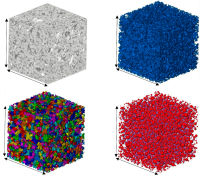Potential Porosity
Potential Porosity

Related publication: https://titipi.org/pub/potentialremoval/
Permanent carbon removal, previously known as “negative emissions”, refers to both the imaginary and the technoscience of a range of processes that seek to eliminate carbon from the atmosphere. It is a techno-economic model based on a violent mix of speculative accounting, and questionable geo-engineering practices. The experimental, speculative and techno-solutionist promise of permanent carbon removal is one in which the underground becomes the site of negative accumulation and the space of spatialised storage of carbon, following the axis of vertical models of extraction. Carbon removal has many indeterminacies, such as the effects on local communities to the validity, value, and technical possibility of it. Despite these ongoing uncertainties both state and industry actors including the IPCC, EU and global Big Tech are now focusing on it as their preferred top-down method to approach climate change. Not at least because it has recently gained traction because the financial elite has found ways to make carbon removal into a market that according to their own predictions could eventually be bigger than the oil market itself.
As a contribution to the Misplacing matter? workshop, we propose to tell the inframaterial story of “mineral carbonization”, a particular form of artificial carbon sequestration and so-called “enhanced mineralization”. Carbonated fluids are injected into the voids of porous basalt, triggering a process of fast calcification through the chemical interaction between silicate rock and fizzy water. The story follows risky experiments with the potential of porosity, from a reliance on the stabilizing force of minerals to hold carbon until the end of time, into the infinite ambitions of a resource intensive, expansive computational infrastructure to efficiently fill all planetary gaps eventually.[1] Mineral carbonization re-invents the underground as a resource for exploitation, counting on hypercomputation for binding geological time to agile geopolitics. Instead of transforming politics or abolishing racial capitalism based on oil economies, it opts once again for solidifying familiar displacements.
The Institute for Technology in the Public Interest is a trans-practice collaboration between Helen Pritchard, Seda Guerses, Miriyam Aouragh, Femke Snelting and Jara Rocha. We convene communities to articulate, activate and re-imagine together what computational technologies in the “public interest” might be when “public interest” is always in-the-making.[2] Potential Porosity (working title) contributes to the preparation of a bugreport on Frontier Climate, a powerful consortium between Big Tech companies and a global consultancy firm. Frontier Climate offers investors a computational-cloud-based-infrastructure for both creating a market and an opportunity for accumulation through what they call “advance market commitments”.
(workshop proposal, September 2023)
- ↑ Pritchard, Helen V., Jara Rocha, and Femke Snelting. “Figurations of Timely Extraction.” Media Theory 4, no. 2 (2020): 159–88. https://journalcontent.mediatheoryjournal.org/index.php/mt/article/view/123
- ↑ https://titipi.org